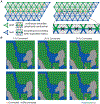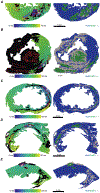Graft-host coupling changes can lead to engraftment arrhythmia: a computational study
- PMID: 37014103
- PMCID: PMC10901678
- DOI: 10.1113/JP284244
Graft-host coupling changes can lead to engraftment arrhythmia: a computational study
Abstract
After myocardial infarction (MI), a significant portion of heart muscle is replaced with scar tissue, progressively leading to heart failure. Human pluripotent stem cell-derived cardiomyocytes (hPSC-CM) offer a promising option for improving cardiac function after MI. However, hPSC-CM transplantation can lead to engraftment arrhythmia (EA). EA is a transient phenomenon arising shortly after transplantation then spontaneously resolving after a few weeks. The underlying mechanism of EA is unknown. We hypothesize that EA may be explained partially by time-varying, spatially heterogeneous, graft-host electrical coupling. Here, we created computational slice models derived from histological images that reflect different configuration of grafts in the infarcted ventricle. We ran simulations with varying degrees of connection imposed upon the graft-host perimeter to assess how heterogeneous electrical coupling affected EA with non-conductive scar, slow-conducting scar and scar replaced by host myocardium. We also quantified the effect of variation in intrinsic graft conductivity. Susceptibility to EA initially increased and subsequently decreased with increasing graft-host coupling, suggesting the waxing and waning of EA is regulated by progressive increases in graft-host coupling. Different spatial distributions of graft, host and scar yielded markedly different susceptibility curves. Computationally replacing non-conductive scar with host myocardium or slow-conducting scar, and increasing intrinsic graft conductivity both demonstrated potential means to blunt EA vulnerability. These data show how graft location, especially relative to scar, along with its dynamic electrical coupling to host, can influence EA burden; moreover, they offer a rational base for further studies aimed to define the optimal delivery of hPSC-CM injection. KEY POINTS: Human pluripotent stem cell-derived cardiomyocytes (hPSC-CM) hold great cardiac regenerative potential but can also cause engraftment arrhythmias (EA). Spatiotemporal evolution in the pattern of electrical coupling between injected hPSC-CMs and surrounding host myocardium may explain the dynamics of EA observed in large animal models. We conducted simulations in histology-derived 2D slice computational models to assess the effects of heterogeneous graft-host electrical coupling on EA propensity, with or without scar tissue. Our findings suggest spatiotemporally heterogeneous graft-host coupling can create an electrophysiological milieu that favours graft-initiated host excitation, a surrogate metric of EA susceptibility. Removing scar from our models reduced but did not abolish the propensity for this phenomenon. Conversely, reduced intra-graft electrical connectedness increased the incidence of graft-initiated host excitation. The computational framework created for this study can be used to generate new hypotheses, targeted delivery of hPSC-CMs.
Keywords: Arrhythmia; computer modelling; hPSC-CM.
© 2023 The Authors. The Journal of Physiology © 2023 The Physiological Society.
Figures








Similar articles
-
Modelling the interaction between stem cells derived cardiomyocytes patches and host myocardium to aid non-arrhythmic engineered heart tissue design.PLoS Comput Biol. 2022 Apr 1;18(4):e1010030. doi: 10.1371/journal.pcbi.1010030. eCollection 2022 Apr. PLoS Comput Biol. 2022. PMID: 35363778 Free PMC article.
-
Assessing the arrhythmogenic risk of engineered heart tissue patches through in silico application on infarcted ventricle models.Comput Biol Med. 2023 Mar;154:106550. doi: 10.1016/j.compbiomed.2023.106550. Epub 2023 Jan 13. Comput Biol Med. 2023. PMID: 36701966
-
Pluripotent stem cell-based cardiac regenerative therapy for heart failure.J Mol Cell Cardiol. 2024 Feb;187:90-100. doi: 10.1016/j.yjmcc.2023.12.001. Epub 2024 Feb 6. J Mol Cell Cardiol. 2024. PMID: 38331557 Review.
-
Cardiomyocytes from CCND2-overexpressing human induced-pluripotent stem cells repopulate the myocardial scar in mice: A 6-month study.J Mol Cell Cardiol. 2019 Dec;137:25-33. doi: 10.1016/j.yjmcc.2019.09.011. Epub 2019 Oct 17. J Mol Cell Cardiol. 2019. PMID: 31629738 Free PMC article.
-
Human pluripotent stem cell-based cardiac repair: Lessons learned and challenges ahead.Adv Drug Deliv Rev. 2025 Jul;222:115594. doi: 10.1016/j.addr.2025.115594. Epub 2025 May 5. Adv Drug Deliv Rev. 2025. PMID: 40334814 Review.
Cited by
-
Cell diversity and signalling in the cardiovascular system.J Physiol. 2023 Jul;601(13):2537-2539. doi: 10.1113/JP284979. Epub 2023 May 27. J Physiol. 2023. PMID: 37211722 Free PMC article. No abstract available.
-
Pluripotent stem cell-derived cardiomyocyte transplantation: marching from bench to bedside.Sci China Life Sci. 2025 May 23. doi: 10.1007/s11427-024-2801-x. Online ahead of print. Sci China Life Sci. 2025. PMID: 40418524 Review.
-
In silico evaluation of cell therapy in acute versus chronic infarction: role of automaticity, heterogeneity and Purkinje in human.Sci Rep. 2024 Sep 16;14(1):21584. doi: 10.1038/s41598-024-67951-5. Sci Rep. 2024. PMID: 39284812 Free PMC article.
-
Bridging the Gap: Advances and Challenges in Heart Regeneration from In Vitro to In Vivo Applications.Bioengineering (Basel). 2024 Sep 24;11(10):954. doi: 10.3390/bioengineering11100954. Bioengineering (Basel). 2024. PMID: 39451329 Free PMC article. Review.
-
Population-based computational simulations elucidate mechanisms of focal arrhythmia following stem cell injection.J Mol Cell Cardiol. 2025 Jul;204:5-16. doi: 10.1016/j.yjmcc.2025.04.010. Epub 2025 Apr 23. J Mol Cell Cardiol. 2025. PMID: 40280466
References
-
- Bahit MC, Kochar A, & Granger CB (2018). Post-myocardial infarction heart failure. JACC Heart Failure, 6(3), 179–186. - PubMed
-
- Balaban G, Costa CM, Porter B, Halliday B, Rinaldi CA, Prasad S, Plank G, Ismail TF, & Bishop MJ (2020). 3D electrophysiological modeling of interstitial fibrosis networks and their role in ventricular arrhythmias in Non-ischemic cardiomyopathy IEEE Transactions on Bio-Medical Engineering, 67(11), 3125–3133. - PMC - PubMed
Publication types
MeSH terms
Grants and funding
LinkOut - more resources
Full Text Sources
Other Literature Sources
Medical
Miscellaneous

